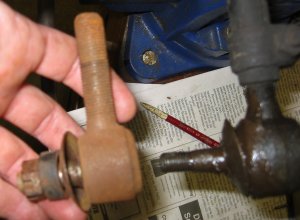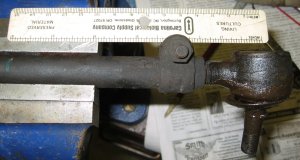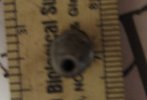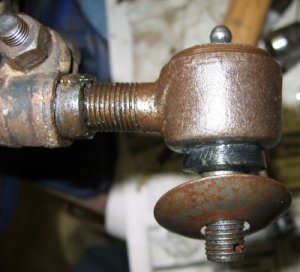 Step
one: Remove the tie rod. While it should be possible to
change the tie rod end with the other end in place it is much easier to
work on things with the tie rod on the bench. So I removed the
cotter pins and loosened the nuts from both tie rod ends then used my
tie-rod-popper-outer tool to break the ends loose. Each tie rod
end has a tapered shaft that is clamped into a matching tapered hole by
the pulling action of the nut. This fit is very tight and without
a tool like this getting them out is a chore. I bought this tool
years ago to work on my VW GTI. It was a little big but
worked just fine. Step
one: Remove the tie rod. While it should be possible to
change the tie rod end with the other end in place it is much easier to
work on things with the tie rod on the bench. So I removed the
cotter pins and loosened the nuts from both tie rod ends then used my
tie-rod-popper-outer tool to break the ends loose. Each tie rod
end has a tapered shaft that is clamped into a matching tapered hole by
the pulling action of the nut. This fit is very tight and without
a tool like this getting them out is a chore. I bought this tool
years ago to work on my VW GTI. It was a little big but
worked just fine. |

Once I had the tie rod out I clamped it in a vise and compared to the
new part. Looks like a match! You can see the new end is a
little rusty. I cleaned it up with a wire brush and used brake
cleaner to blow out the dirt and debris from the ball joint. The
grease seal (that rubber doohickey under the nut) is a little hardened
with age but worlds better then the destroyed one I found on the old tie
rod end. |
 The
alignment of the front wheels is adjusted by loosening the tie rod end
clamp and screwing the end in and out. So it is vital to keep the
overall length of the tie rod the same when I put the new tie rod end
in. So I measured 6" from the center of the grease fitting hole on
the old tie rod end and marked the tie rod. Now I can put the new
end on so it's center is in the same place and the alignment should be
fine. The
alignment of the front wheels is adjusted by loosening the tie rod end
clamp and screwing the end in and out. So it is vital to keep the
overall length of the tie rod the same when I put the new tie rod end
in. So I measured 6" from the center of the grease fitting hole on
the old tie rod end and marked the tie rod. Now I can put the new
end on so it's center is in the same place and the alignment should be
fine. |
|
 Speaking
of grease fittings the one that was in the tie rod end was bad.
There is supposed to be a spring-loaded ball in the end of the fitting
but on mine the spring and ball were just gone. The fitting was
just a tube. These fittings are actually called "zerks". I
am not making this up. The local hardware store had them so I
bought a couple. Problem solved. Speaking
of grease fittings the one that was in the tie rod end was bad.
There is supposed to be a spring-loaded ball in the end of the fitting
but on mine the spring and ball were just gone. The fitting was
just a tube. These fittings are actually called "zerks". I
am not making this up. The local hardware store had them so I
bought a couple. Problem solved. |
|
 Here
is the new end installed in the tie rod to the correct length with the
new zerk. The grease seal is installed and it is ready to go back
into the car. Here
is the new end installed in the tie rod to the correct length with the
new zerk. The grease seal is installed and it is ready to go back
into the car.
Re-installing was a chore. Remember the tapered hole the tie
rod end fits into? Well on this tie rod end the threads seemed to
stick out a few thousandths of an inch more than they should. The
end would NOT fit in the hole. It was really close
but no cigar. I ended up running a thread-cutting die up and down
the threads then I rubbed them with emery cloth to round off the peaks
on the threads a bit. After that it fit. I don't know who
made this tie rod end but they had quality issues. |
|
 Here is the "end" result ready to go! Now I can just hear the masses
saying: "Nathan you putz, you forgot the cotter pin! Well not
quite. I have a whole box of cotter pins. I even have both
sizes. Too big and too small. I had to make another hardware
store run for the right size cotter pins. They have been installed and
the fittings greased. The new end works great. This is the first
step in getting the steering tighter!
Here is the "end" result ready to go! Now I can just hear the masses
saying: "Nathan you putz, you forgot the cotter pin! Well not
quite. I have a whole box of cotter pins. I even have both
sizes. Too big and too small. I had to make another hardware
store run for the right size cotter pins. They have been installed and
the fittings greased. The new end works great. This is the first
step in getting the steering tighter! |





